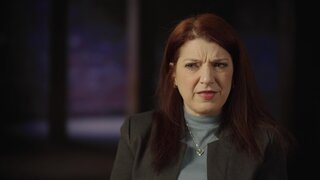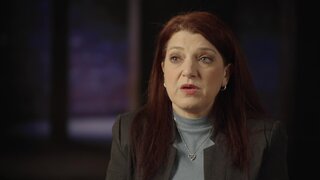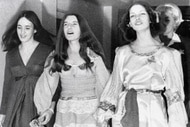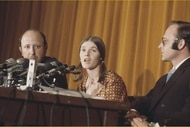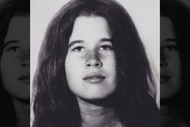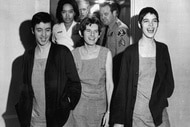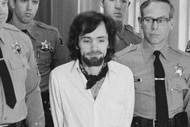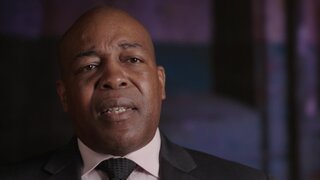Create a free profile to get unlimited access to exclusive videos, breaking news, sweepstakes, and more!
Detectives Search for Fake Doctor Suspected of Killing Missing Manhattan Banker
N.Y.P.D. detectives believed Maria Cruz visited Dean Faiello — a man purporting to be a dermatologist — just before her 2003 disappearance. Months later, Faiello's ex came forward with a crucial detail.
N.Y.P.D. detectives questioned what came of a Filipino woman who disappeared while living out the American dream in Manhattan. But things soon took a dark twist when they discovered the doctor she’d planned to meet had a criminal past and a secret life.
Monday mornings in New York City are typically fast-paced and demanding for those working in international finance. So, when 35-year-old senior credit analyst Maria Cruz was a no-show on Monday, April 14, 2003, at Barclay’s Capital in Manhattan, red flags immediately went up, according to N.Y.P.D. Detective T.J. Moroney.
“Maria Cruz was a very consistent woman; she never missed work,” Moroney told New York Homicide, airing Saturdays at 9/8c on Oxygen. “She was a person of routine.”
Loved ones grew more concerned when just days later, Cruz failed to meet her brother and other relatives at the airport when they arrived from their native Philippines. It was out of character for Cruz, whom Det. Joe Buffolino referred to as someone who was otherwise a “responsible individual.”
RELATED: Maitre D's Slaying on New York City’s “Restaurant Row” Helps Solve Cold Case Murder
Cruz was described as a devout Catholic and intelligent Fordham University student who’d graduated with honors when earning her M.B.A. degree.
“She was smart, she was dedicated, and she was very ambitious,” said Diane Fanning, author of Under the Knife. “She was an immigrant success story.”
Cruz’s Priest, Father Erno Diaz of St. Malachy’s in Manhattan, said Cruz came to “pursue her American dream.”
An uncle reported Cruz missing, and detectives visited Cruz’s West 50th Street apartment in Hell’s Kitchen, finding newspapers piled up outside her door. The building’s superintendent let police in, though the apartment was “pristine,” according to Det. Maroney.
Police found no reason for Cruz to up and leave.
The Search for Maria Cruz Is On
Investigators hoped to glean information about Cruz’s last movements via her apartment building’s surveillance system. Cameras captured the missing person mid-morning on Sunday, Apr. 13, just one day before she failed to show up to work.
“So, we know we had Maria leaving the building, but we never had her returning to the building,” said Det. Moroney.
She was last seen attending mass at St. Malachy’s, though police and loved ones had no information beyond that. Missing posters went up, and detectives canvassed the neighborhood to no avail.
“Was she abducted? Was she kidnapped? Was she killed?” asked Fr. Diaz.
A look into Cruz’s cell phone records and bank card purchases revealed that, on Sunday, Apr. 13, Cruz withdrew $400 from an A.T.M. at Loehmann’s department store in Lower Manhattan. Surveillance video of the transaction showed Cruz was alone.
No new leads came, and after a couple of months, Cruz’s loved ones returned to the Philippines. The break detectives needed wouldn’t come until six months after Cruz’s disappearance when her e-mail records were returned to detectives.
They showed that on April 13, 2003, Cruz had a doctor’s appointment with a dermatologist named Dean Faiello, whom she planned to meet in Lower Manhattan. Faiello requested she bring $400 in cash so he could purchase lidocaine and syringes.
“That’s a huge red flag,” Det. Maroney told New York Homicide.
A look into Faiello quickly showed that not only was he not a certified dermatologist, but he also had a criminal record for practicing medicine without a license.
Who was Dean Faiello?
In 1998 — five years before Cruz’s disappearance — Faiello shared an office with dermatologist Dr. Laurie Polis, whose licensed and board-certified practice was separate from Faiello’s.
“He was this young, good-looking, strapping, well-spoken, affable young man,” Polis told New York Homicide.
Polis said the openly-gay Faiello previously worked at a spa. While he wasn’t a doctor, he practiced electrolysis, which didn’t require a medical license. Faiello had a keen interest in Polis’s advanced work in laser hair removal and cosmetic surgery, which required state licensure.
Several months later, Faiello told Polis and others he was dying of A.I.D.S. and decided to move to Florida to live out his final days.
“Never did it occur to me that it wouldn’t be true,” said Polis.
Several weeks later, Polis found an advertisement in a New York magazine, where Faiello presented himself as a “certified laserist.” Not only did Polis learn Faiello lied about moving away, but “most alarming” was that Faiello was out there as an unqualified practitioner.
“If a patient had a cardiac arrest or event on his table, he didn’t have the skills to deal with something if it went wrong,” said Polis. “Having a laser wand is like having a gun in your hand.”
RELATED: Two Young Women with Big City Dreams Found Dead in Upper West Side Double Murder
To make matters worse, Polis received a call from a third-party medical insurance group inquiring why she was prescribing excessive amounts of Stadol, a potent and fast-acting narcotic (often used as a nasal spray) with effects similar to morphine. Investigators in 1998 discovered Dr. Polis’s prescription pad had been stolen.
“My signature had been forged,” Polis told New York Homicide. “And, shockingly, the patient’s name was Dean Faiello.”
In January 1999, Faiello was convicted of forging prescriptions. He was sentenced to three years probation and court-mandated drug rehabilitation.
Following a second investigation into Faiello’s practices, with the help of the New York State Attorney General’s Office, police learned Faiello continued to perform dermatology services without a license, leading to his October 3, 2002, arrest — just six months before Maria Cruz’s disappearance.
Faiello’s boyfriend posted his bail, allowing the fraud to remain free.
“He knew he wasn’t supposed to be doing it [practicing medicine], but we found out later he was still doing it at a friend’s apartment on 16th Street,” said Investigator Brian Ford of the Attorney General’s office.
Detectives looking into Cruz’s vanishing became convinced that she went to see Faiello for dermatological services on Apr. 13, 2003. They wondered if Faiello had anything to do with her same-day disappearance, perhaps following a botched medical procedure.
In June 2003, Faiello failed to attend a court hearing related to his previous charges of practicing medicine without a license. Investigator Ford of the A.G.’s office found Faiello used his passport to flee the country, landing in Costa Rica.
As detectives continued building their case, Ford received a phone call “out of the clear blue” from Faiello’s ex-boyfriend, Greg Bach. Bach told New York Homicide that he loved Faiello and referred to him as his other half.
“I was invested in trying to keep him from ruining his life anymore,” said Bach. “But then what happened in exchange was he ended up ruining mine, and I wasn’t going to let him get away with what he did.”
Faiello’s ex-boyfriend gives investigators new information
Bach told investigators that, in 1998, he and Faiello spent weekends at Faiello’s home in Newark, New Jersey. At the time, Bach found him “charismatic” and “handsome,” a successful skin care specialist who’d achieved sobriety from drugs. But according to Bach, it wasn’t long before Faiello relapsed.
“He owed money in every direction,” Bach told New York Homicide. “The mortgage hadn’t been paid in months. Credit card debts were through the roof. He’d been borrowing money from me, and then I had to post bail.”
In total, Bach lent Faiello about $82,000. It was when trying to recoup his monies that Bach learned Faiello fled for Costa Rica.
“That really pissed me off,” Bach continued. “It wounded me.”
Bach was unaware of missing woman Maria Cruz, only learning of her after speaking to prosecutors about Faiello’s 2002 criminal charges. But he knew through mutual friends that Faiello allegedly had a patient in April 2003 — the same time Cruz disappeared — and performed a medical procedure that went south. Friends said Faiello frantically called them, and the friends advised Faiello to take his “patient” to the hospital or call 9-1-1.

Faiello later called the friends back to say everything was fine after he took the patient to a local hospital. However, a later investigation found no evidence that Cruz received medical attention.
“When [Bach] tells us this information, we strongly believe that this may help us find Maria Cruz,” Det. T.J. Maroney told New York Homicide.
Upon learning about Cruz, Bach suddenly remembered Faiello undertaking a “cement project” in his Newark, New Jersey, garage around that same time. The supposed project included digging a hole through the floor and “a terrible odor coming from the site,” Det. Joe Buffolino said.
“That is an ‘oh sh-t’ moment,” said Det. Moroney.
In February 2004, following the issuance of a search warrant, cadaver dogs led investigators straight to a spot in the garage floor. Using shovels and picks to dig, detectives discovered a suitcase containing Maria Cruz’s plastic-wrapped body.
Father Erno Diaz conducted a memorial service for Cruz at St. Malachy’s before her distraught family brought her back to the Philippines for burial.
An Uphill Battle for Prosecutors
The discovery of Cruz’s body became headline news, and Faiello was formally charged with murder. N.Y.P.D. detectives sought Faiello in Costa Rica, contacting Central American authorities for help and having the media circulate the suspect’s photo.
“This security guy at this nice resort had seen his photo,” author Diane Fanning told New York Homicide. “He told the manager right away, ‘We’ve got a murderer at the hotel.’”
But, according to Fanning, the manager liked Faiello and helped him retain an attorney before New York detectives visited him in a San José jail. Det. Buffolino said it appeared he “didn’t have a care in the world.”
Soon, Faiello’s lawyer hatched a plan to try and expedite Cruz’s status as a Costa Rican citizen, going as far as to try and have a younger couple try and adopt the murder suspect. A judge, however, ruled Faiello — then in his 40s — was too old to be adopted.
After a year of legal delays, Faiello was returned to the United States and booked to Riker’s Island on charges of second-degree murder, to which he pleaded not guilty.
On July 25, 2005, Faiello agreed to give his version of events as part of a plea deal in exchange for lesser criminal charges. According to Faiello’s courtroom statements, Cruz contacted Faiello about an undisclosed but common medical procedure in the upper region of her body. Faiello allayed any fears Cruz might have had, saying he’d first numb the area.
RELATED: Jail Informant Sends NYPD Detectives on a Frantic Search for a High-Rise Crime Scene
“Dean went to inject her tongue with lidocaine,” Dr. Polis told New York Homicide. “Lidocaine has what we call cardiotoxicity. It’s dangerous to the heart in certain doses; we have to be very careful how much lidocaine we use. But Dean wouldn’t know that. He was not a doctor.”
Faiello told the court he was under the influence of several substances — including cocaine — when Cruz began convulsing soon after the procedure started. He admitted to calling his friends, and while they advised him to get help, Faiello ignored their requests.
Faiello confessed to storing Cruz’s body in a suitcase before transporting it to his Newark home, hiding it under the cement of his garage.
As part of the plea deal, Faiello pleaded guilty to first-degree assault and was sentenced to 20 years behind bars. According to Investigator Ford, murder charges could not be pursued because a cause of death was never determined.
“The police put a closure to a grieving family, to a grieving parish, to a grieving city,” said Fr. Diaz. “I prayed for the soul of Maria, that she would rest in peace.”
Watch more New York Homicide, airing Saturdays at 9/8c on Oxygen.


